Experimental Study on the Vegetation Growing Recycled Concrete and Synergistic Effect with Plant Roots
Abstract
:1. Introduction
2. Materials and Methodology
2.1. Specimen Making
2.2. Test Method
3. Study on Mechanical Properties of Vegetation Growing Recycled Concrete (VGRC)
3.1. Mechanical Properties of Ultrafine Slag Cement Mortar
3.2. Compressive Strength
3.3. Splitting Tensile Strength
3.4. Frost Resistance Performance
4. Pore Analysis and 3D Reconstruction
4.1. Pore Spatial Morphology and Parameter
4.2. Relation between Pore Sphericity and Pore Diameter
4.3. Pore Plane Distribution Characteristics
5. Alkali Reduction Treatment of Vegetation Growing Recycled Concrete (VGRC) and Selection of Plant Material
5.1. Modification of Alkali Environment in the Pores of Vegetation Growing Recycled Concrete (VGRC)
5.2. Ratio and Properties of Plant Substrate
6. Compatibility of Vegetation Growing Recycled Concrete (VGRC) and Plants
6.1. Lawn Adaptability
6.2. Influencing of Plant Root System on Vegetation Growing Recycled Concrete (VGRC) Performance
7. Conclusions
- (1)
- The strength of cement mortar increases first and then decreases with the increase of ultrafine slag replacement rate. The XRD analysis shows that the content of Ca(OH)2 in the hydration products of 28-days cement mortar decreases significantly with the addition of ultrafine slag. The unhydrated ultrafine slag has a filling micropore function.
- (2)
- Porosity plays a decisive role among many factors affecting the compressive strength of VGRC. The compressive strength decreases gradually with the increase of porosity. The compressive strength and planting demand can be satisfied when the porosity is 20%–25%. The aggregate quality and cementitious strength are the main factors affecting compressive strength under the large porosity, while the influence of the aggregate size and water–cement ratio is small. The strength of cementitious materials can be improved by adding ultrafine slag, and the optimum dosage is 40%.
- (3)
- The compressive strength of VGRC is greatly damaged by the fast freezing method. After 50 freeze-thaw cycles, the strength loss rate is 8%–55%. However, the degree of damage of natural freeze-thaw is relatively small.
- (4)
- The alkaline environment in the concrete pores is mainly caused by alkaline substances in the cement mortar. The pore pH value can be reduced by 0.16–0.57 by changing the composition of the cementitious materials and spraying a modified solution. The pore pH value can be reduced to below 8 by ferrous sulfate solution soaking of 6 days, oxalic acid solution soaking of 10 days, or water soaking of 26 days.
- (5)
- Most grass species such as tall fescue can grow normally in vegetation concrete. The roots can penetrate 6-cm thick VGRC blocks after being planted for 60 days.
- (6)
- The compressive strength of the VGRC decreases greatly after turf planting, and the increase in porosity can reduce the weakening effect of vegetation on the strength. The permeability coefficient of VGRC increases with the increase of porosity and aggregate size. The permeability coefficient decreases greatly after turf planting and overbite soil but is still higher than that of common soil. After being planted for 120 days, the effect of freeze-thaw cycles on the concrete strength decreases, and the aggregate size and porosity have no significant correlation with the frost resistance.
Author Contributions
Funding
Conflicts of Interest
References
- Sumanasooriya, M.S.; Neithalath, N. Pore structure features of pervious concretes proportioned for desired porosities and their performance prediction. Cem. Concr. Comp. 2011, 33, 778–787. [Google Scholar] [CrossRef]
- Okamoto, T.; Masui, N. Manufacture of porous concrete. Korea Concr. Inst. 2000, 12, 29–32. [Google Scholar]
- Bhutta, M.A.R.; Tsuruta, K.; Mirza, J. Evaluation of high-performance porous concrete properties. Constr. Build. Mater. 2012, 31, 67–73. [Google Scholar] [CrossRef]
- Kevern, J.T.; Nowasell, Q.C. Internal curing of pervious concrete using lightweight aggregates. Constr. Build. Mater. 2018, 161, 229–235. [Google Scholar] [CrossRef]
- Kyung, H.L.; Keun, H.Y. Development of a neutral cementitious material to promote vegetation concrete. Constr. Build. Mater. 2016, 127, 442–449. [Google Scholar]
- Mohammed, B.S.; Liew, M.S.; Alaloul, W.S. Properties of Nano-Silica Modified Pervious Concrete. Case Stud. Constr. Mater. 2018, 8, 409–422. [Google Scholar] [CrossRef]
- Oh, R.O.; Cha, S.S.; Park, C.G. Mechanical properties and water purification characteristics of natural jute fiber-reinforced non-cement alkali-activated porous vegetation blocks. Paddy Water Environ. 2014, 12, 149–156. [Google Scholar] [CrossRef]
- Ghashghaei, H.T.; Hassani, A. Investigating the relationship between porosity and permeability coefficient for pervious concrete pavement by statistical modeling. Mater. Sci. Appl. 2016, 7, 101–107. [Google Scholar]
- Huang, B.; Wu, H.; Shu, X. Laboratory evaluation of permeability and strength of polymer-modified pervious concrete. Constr. Build. Mater. 2010, 24, 818–823. [Google Scholar] [CrossRef]
- Lian, C.; Zhuge, Y.; Beecham, S. The relationship between porosity and strength for porous concrete. Constr. Build. Mater. 2011, 25, 4294–4298. [Google Scholar] [CrossRef]
- Jang, J.G.; Ahn, Y.B.; Souri, H.; Lee, H.K. A novel eco-friendly porous concrete fabricated with coal ash and geopolymeric binder: Heavy metal leaching characteristics and compressive strength. Constr. Build. Mater. 2015, 79, 173–181. [Google Scholar] [CrossRef]
- Deo, O.; Neithalath, N. Compressive response of pervious concretes proportioned for desired porosities. Constr. Build. Mater. 2011, 25, 4181–4189. [Google Scholar] [CrossRef]
- Codina, M.; Cau-dit-Coumes, C.; Bescop, P.L.; Verdier, J.; Ollivier, J.P. Design and characterization of low-heat and low-alkalinity cements. Cem. Concr. Res. 2007, 38, 437–448. [Google Scholar] [CrossRef]
- Qi, Q. Experimental Study and Application of Forst-Resistant Vegetation Concrete Alkaline-Reducing Planting Technology. Master’s Thesis, Shandong Agricultural University, Shandong, China, 2018. [Google Scholar]
- Räsänen, V.; Penttala, V. The pH measurement of concrete and smoothing mortar using a concrete powder suspension. Cem. Concr. Res. 2003, 34, 813–820. [Google Scholar] [CrossRef]
- Wong, N.H.; Chen, Y.; Ong, C.L.; Sia, A. Investigation of thermal benefits of rooftop garden in the tropical environment. Build Environ. 2003, 38, 261–270. [Google Scholar] [CrossRef]
- Kim, Y.; Hanif, A.; Kazmi, S.M.S. Properties enhancement of recycled aggregate concrete through pretreatment of coarse aggregates–Comparative assessment of assorted techniques. J. Clean. Prod. 2018, 191, 339–349. [Google Scholar] [CrossRef]
- Zhao, Z.; Remond, S.; Damidot, D. Influence of fine recycled concrete aggregates on the properties of mortars. Constr. Build. Mater. 2015, 81, 179–186. [Google Scholar] [CrossRef]
- Guo, H.; Shi, C.; Guan, X. Durability of recycled aggregate concrete–a review. Cem. Conc. Compos. 2018, 89, 251–259. [Google Scholar] [CrossRef]
- Yap, S.P.; Chen, P.Z.C.; Goh, Y. Characterization of pervious concrete with blended natural aggregate and recycled concrete aggregates. J. Clean. Prod. 2018, 181, 155–165. [Google Scholar] [CrossRef]
- Rahman, M.A.; Imteaz, M.A.; Arulrajah, A. Recycled construction and demolition materials in permeable pavement systems: Geotechnical and hydraulic characteristics. J. Clean. Prod. 2015, 90, 183–194. [Google Scholar] [CrossRef]
- Gelong, X.; Weiguo, S.; Bingliu, Z. Properties of recycled aggregate concrete prepared with scattering-filling coarse aggregate process. Cem. Conc. Compos. 2018, 93, 19–29. [Google Scholar]
- Yang, J.; Jiang, G. Experimental study on properties of pervious concrete pavement materials. Cem. Concr. Res. 2003, 33, 381–386. [Google Scholar] [CrossRef]
- Yan, X.; Gong, C.; Wang, S. Effect of aggregate coating thickness on pore structure features and properties of porous ecological concrete. Mag. Concr. Res. 2013, 65, 962–969. [Google Scholar] [CrossRef]
- Ji, B.S. Experimental Study on Microporous Ecological Concrete. Master’s Thesis, Qingdao University of Technology, Qingdao, China, 2013. [Google Scholar]
- Taniguchi, S.; Nishizaki, I.; Moriyoshi, A. A study of longitudinal cracking in asphalt pavement using CT scanner. Road Mater. Pavement. 2008, 9, 549–558. [Google Scholar] [CrossRef]
- Bameyback, R.S.; Diamond, S. Expression and analysis of pore fluids from hardened cement pastes and mortars. Cem. Concr. Res. 1981, 11, 279–285. [Google Scholar] [CrossRef]
- Taylor, H.F.W. A method for predicting alkali ion concrete reactions in cement pore solutions. Adv. Cem. Res. 1987, 1, 5–16. [Google Scholar] [CrossRef]
- Ahn, T.W.; Choi, I.S.; Oh, J.M. A study on water quality purification function by using planting concrete and porous concrete. Environ. Impact Assess. 2008, 17, 271–278. [Google Scholar]
- Zhao, J. Research on Reduction of Alkali and Protective Slope of the Recycled Brick Aggregate Porous Concrete. Master’s Thesis, Shandong Agricultural University, Shandong, China, 2017. [Google Scholar]





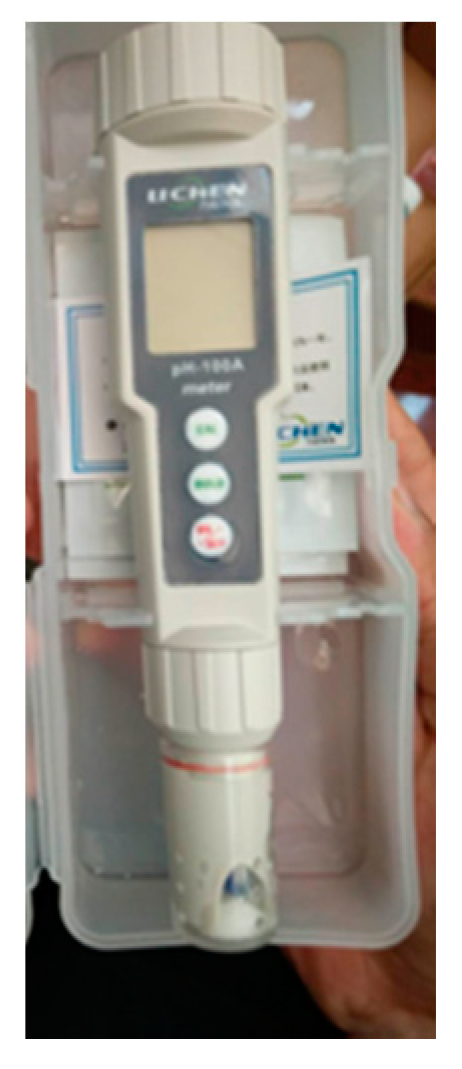

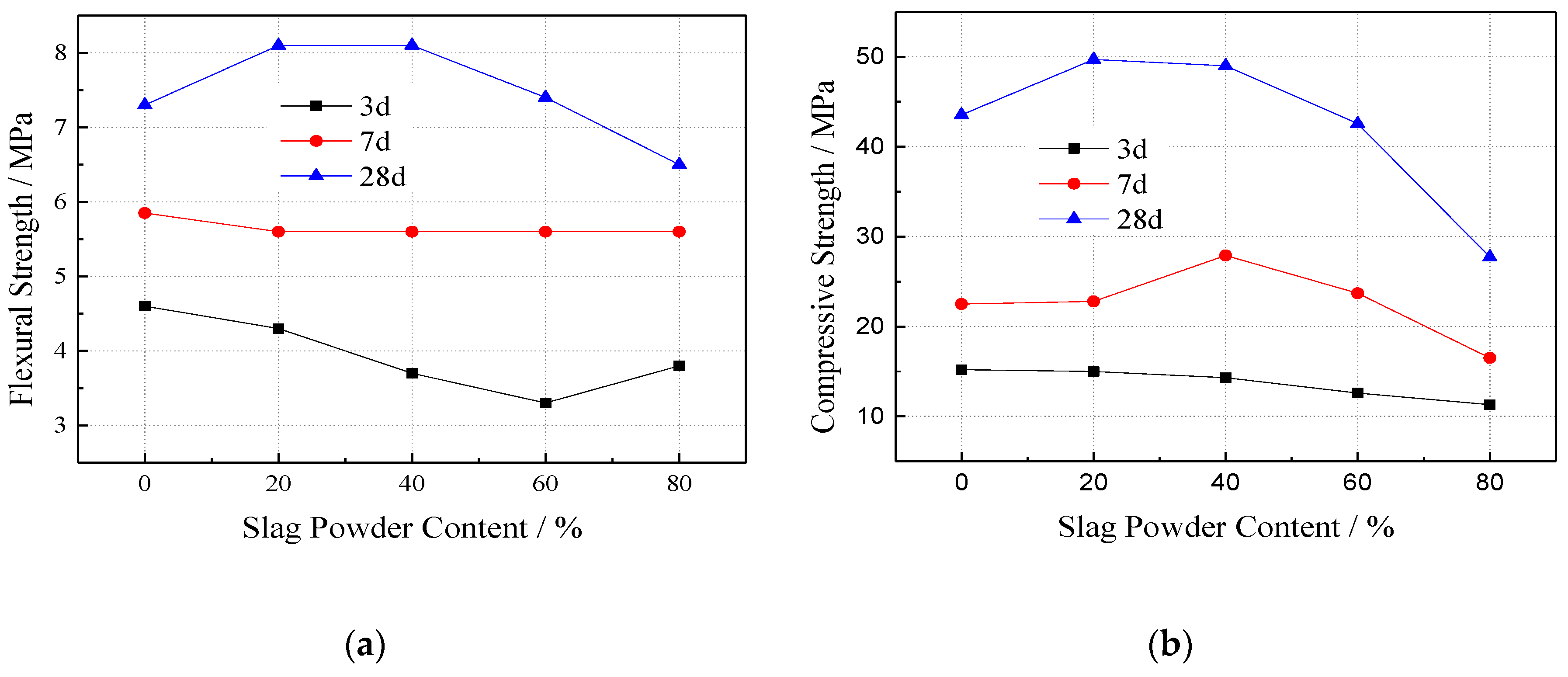

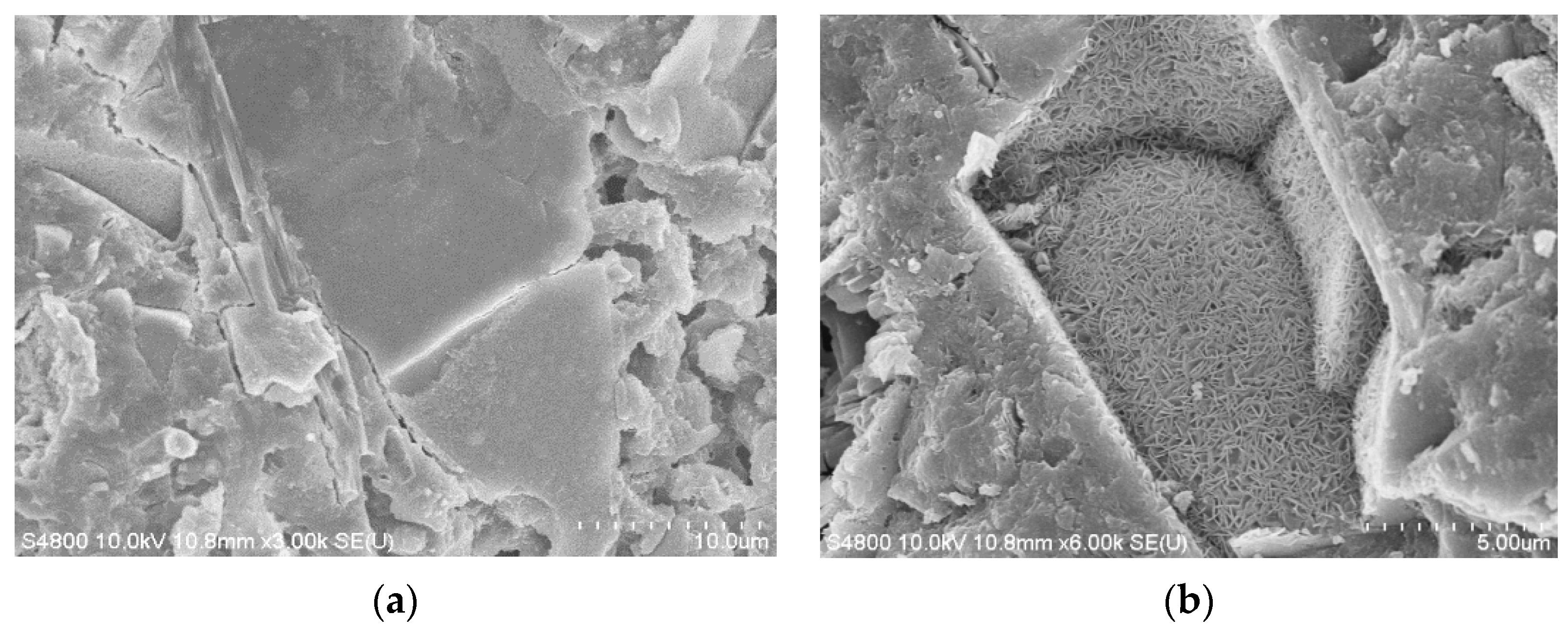















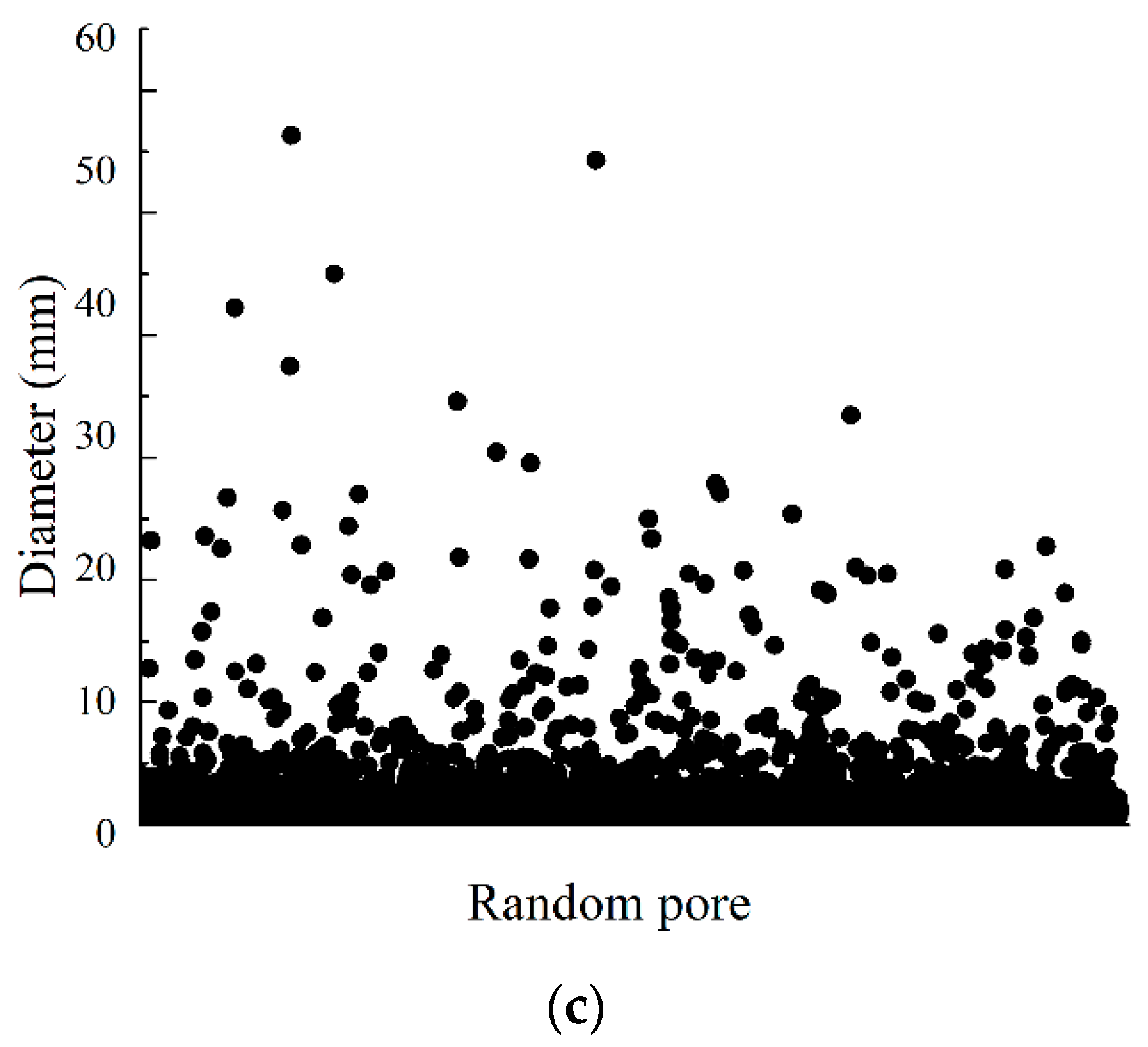







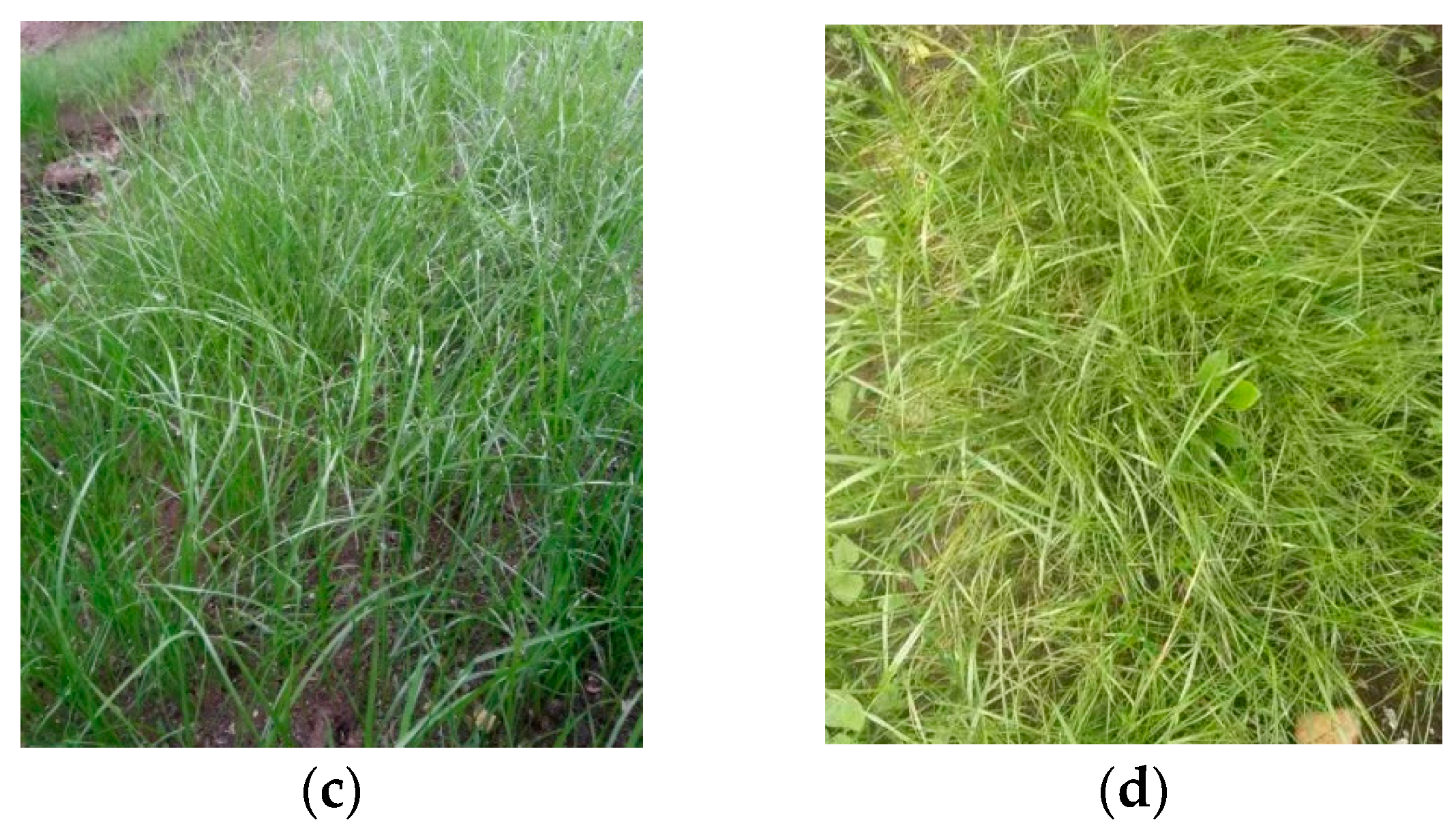




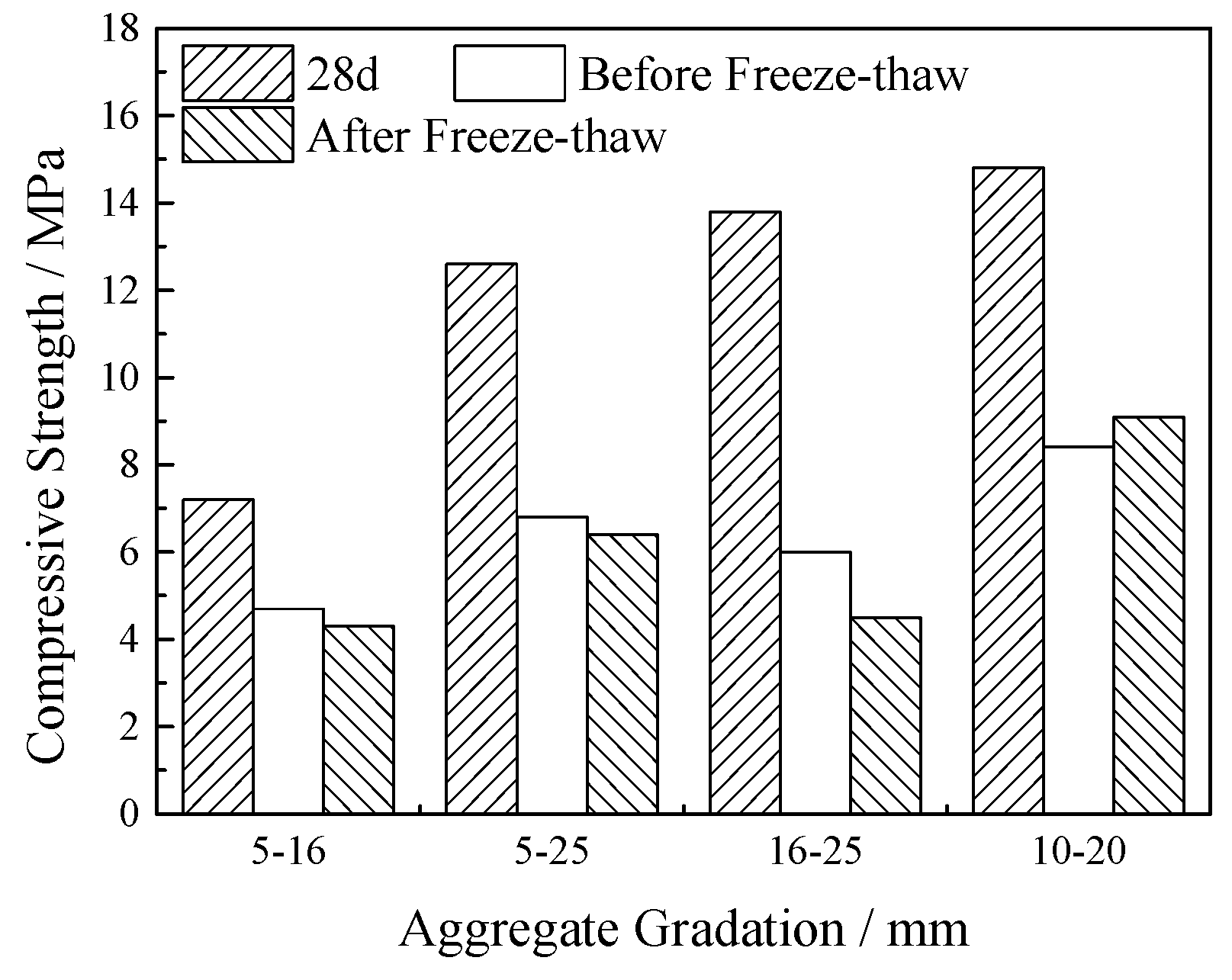
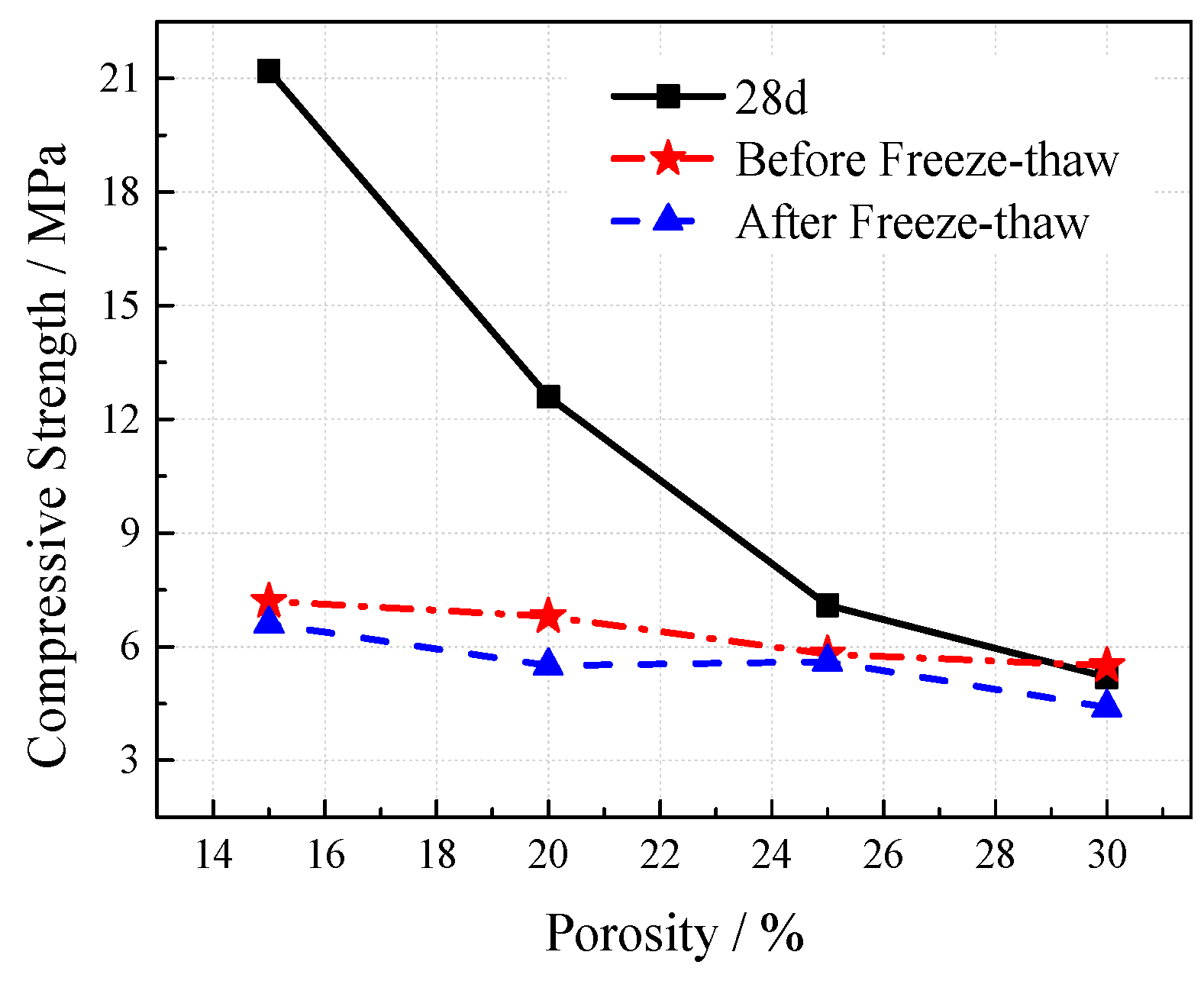
| Aggregate Type | Aggregate Size/mm | Apparent Density/(kg/m3) | Bulk Density/(kg/m3) | Crushing Index/% | Water Absorption of 10 min/% |
|---|---|---|---|---|---|
| Recycled Aggregate | 5–25 | 2390 | 1332 | 17.9 | 4.76 |
| Ordinary Aggregate | 5–25 | 2520 | 1470 | 9.3 | 1.92 |
| Composition | Na2O | MgO | Al2O3 | SiO2 | K2O | CaO | Fe2O3 | SO3 | Loss of Ignition |
|---|---|---|---|---|---|---|---|---|---|
| Content | 0.3 | 4.38 | 13.58 | 30.78 | 0.82 | 44.61 | 0.92 | 3.08 | 1.08 |
| Group | Water Cement Ratio | Porosity (%) | Cement (kg/m3) | Slag (kg/m3) | Water (kg/m3) | Coarse Aggregate (kg/m3) | Water Reducer (g/m3) |
|---|---|---|---|---|---|---|---|
| A1 | 0.23 | 20 | 185.3 | 278 | 106.6 | 1305 | 3.24 |
| A2 | 0.25 | 20 | 179 | 268.5 | 111.9 | 1305 | 2.46 |
| A3 | 0.27 | 20 | 173 | 259.6 | 116.8 | 1305 | 2.16 |
| A4 | 0.29 | 20 | 167.5 | 251.2 | 121.4 | 1305 | 1.88 |
| B1 | 0.25 | 15 | 160.5 | 240.8 | 100.3 | 1305 | 2.2 |
| B2 | 0.25 | 20 | 134.8 | 202 | 84.3 | 1305 | 1.85 |
| B3 | 0.25 | 25 | 109 | 153.5 | 68.3 | 1305 | 1.63 |
| B4 | 0.25 | 30 | 83.3 | 125 | 52 | 1305 | 1.18 |
| C1 | 0.25 | 25 | 508.8 | 0 | 127.2 | 1323 | 2.29 |
| C2 | 0.25 | 25 | 407.0 | 101.8 | 127.2 | 1323 | 1.83 |
| C3 | 0.25 | 25 | 305.3 | 203.5 | 127.2 | 1323 | 1.37 |
| C4 | 0.25 | 25 | 203.5 | 305.3 | 127.2 | 1323 | 0.92 |
| C5 | 0.25 | 25 | 101.8 | 407 | 127.2 | 1323 | 0.46 |
| Group | Water Cement Ratio | Porosity/% | 28d Compressive Strength/MPa | Mass Loss Rate/% | Strength Loss Rate/% | ||
|---|---|---|---|---|---|---|---|
| 25 Times | 50 Times | 25 Times | 50 Times | ||||
| A1 | 0.23 | 20 | 8.0 | 1.69 | 3.92 | 33.85 | 55.20 |
| A2 | 0.25 | 20 | 12.9 | 2.46 | 2.74 | 35.21 | 38.05 |
| A3 | 0.27 | 20 | 15.6 | 1.24 | 1.92 | 39.15 | 46.51 |
| A4 | 0.29 | 20 | 13.2 | 0.98 | 5.96 | 43.36 | 54.61 |
| B1 | 0.25 | 15 | 24.5 | 0.01 | 1.03 | 26.65 | 39.67 |
| B2 | 0.25 | 20 | 12.9 | 2.46 | 2.74 | 35.21 | 38.05 |
| B3 | 0.25 | 25 | 7.1 | 2.75 | 0.64 | 2.82 | 8.31 |
| B4 | 0.25 | 30 | 5.8 | 4.34 | 11.90 | 8.65 | 14.42 |
| Group | Aggregate Size/mm | Porosity/% | Water Cement Ratio | Ultrafine Incorporation |
|---|---|---|---|---|
| CT-1 | 16~25 | 30 | 0.25 | 40% |
| CT-2 | 5~25 | 20 | 0.25 | 40% |
| CT-3 | 5~25 | 30 | 0.25 | 40% |
| Manufacturer | Model | Ray Type | Ray Source | Energy/kv | Max Imaging Pixel | Contrast Ratio/% | Resolution/% | Max Spatial Resolution/mm | Typical Detection Time/min |
|---|---|---|---|---|---|---|---|---|---|
| Germany Werth Company | TomoScope HV Compact225 | X ray | Cermet X-ray tube | 225 | 1024*1024 | <1 | <1 | 0.02 | 20 |
| Number | Diameter/mm | Volume/mm3 | Voxel/ind | Surface Area/mm2 | Location x/pixel | Location y/pixel | Location z/pixel |
|---|---|---|---|---|---|---|---|
| 1 | 44.996 | 731.73 | 180503 | 4798.069 | 314 | 358 | 822 |
| 2 | 22.562 | 559.08 | 137914 | 1178.403 | 270 | 265 | 856 |
| 3 | 54.257 | 539.55 | 133095 | 3172.000 | 404 | 548 | 180 |
| 4 | 33.431 | 469.41 | 115795 | 3527.377 | 430 | 191 | 512 |
| 5 | 30.408 | 456.99 | 112731 | 2937.845 | 313 | 579 | 749 |
| 6 | 27.851 | 381.86 | 94198 | 2199.176 | 167 | 180 | 578 |
| 7 | 56.281 | 367.49 | 90653 | 2114.819 | 455 | 492 | 418 |
| 8 | 42.221 | 288.06 | 71059 | 2104.701 | 530 | 387 | 588 |
| 9 | 34.574 | 257.56 | 63536 | 1320.116 | 515 | 537 | 348 |
| 10 | 19.621 | 254.63 | 62812 | 1499.864 | 330 | 235 | 579 |
| …… | |||||||
| 94111 | 1.372 | 0.21 | 53 | 3.356 | 468 | 515 | 524 |
| Coir Dust | Fly Ash | Organic Fertilizer | Peat Soil | Cement | Water Retaining Agent |
|---|---|---|---|---|---|
| 45%~58% | 17%~23% | 20%~25% | 5%~10% | 5%~7% | 0.2%~0.5% |
| Peat Soil | Coir Dust | Organic Fertilizer | Agricultural Water Retaining Agent |
|---|---|---|---|
| 65%~80% | 20%~30% | 3%~5% | 2%~3% |
| Sucrose | Aspirin (Acetylsalicylic Acid) | Auxin 1 | Potassium Dihydrogen Phosphate | |
|---|---|---|---|---|
| 5~10g | 0.4~0.5g | Iaa 0.3g | Naa 0.5g | 27g |
© 2019 by the authors. Licensee MDPI, Basel, Switzerland. This article is an open access article distributed under the terms and conditions of the Creative Commons Attribution (CC BY) license (http://creativecommons.org/licenses/by/4.0/).
Share and Cite
Wang, F.; Sun, C.; Ding, X.; Kang, T.; Nie, X. Experimental Study on the Vegetation Growing Recycled Concrete and Synergistic Effect with Plant Roots. Materials 2019, 12, 1855. https://doi.org/10.3390/ma12111855
Wang F, Sun C, Ding X, Kang T, Nie X. Experimental Study on the Vegetation Growing Recycled Concrete and Synergistic Effect with Plant Roots. Materials. 2019; 12(11):1855. https://doi.org/10.3390/ma12111855
Chicago/Turabian StyleWang, Fengchi, Chang Sun, Xiangqun Ding, Tianbei Kang, and Xiaomei Nie. 2019. "Experimental Study on the Vegetation Growing Recycled Concrete and Synergistic Effect with Plant Roots" Materials 12, no. 11: 1855. https://doi.org/10.3390/ma12111855




